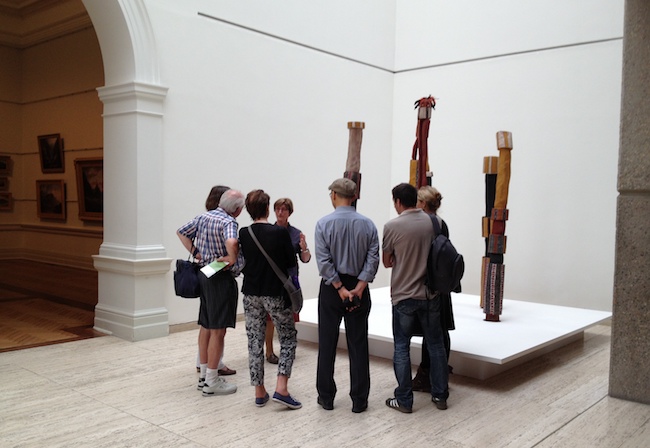Audiences at the Art Gallery of New South Wales; Photo Gina Fairley, Artshub
Today we get our news from many sources. While the 24-hour news cycle has made information more democratically available, the truth and trust in that information has diminished.
In contrast, museums are generally perceived as experts, custodians and caretakers for society, and have a high level of trust.
A study in America proved that today, people trust museums more than they trust newspapers.
The National Awareness, Attitude & Usage Study of Visitor-Serving Organizations (NAAU) has been collecting data since 2010. It is an ongoing study that quantifies the opinions, perceptions, and behaviors of more than 100,000 US adults concerning visitor-serving organisations, such as museums, zoos, aquariums, botanic gardens, and performing arts organisations to better understand their current and potential audiences.
Colleen Dilenschneider is the Chief Market Engagement Officer for IMPACTS, a partner organisation in the study and global leader in predictive market intelligence made the following summary.
She believes that knowing how much people trust museums is important information for developing relevant and sustainable organisations. ‘Remember, your organisation may declare importance, but the market determines relevance,’ she reminded.
So, why do people trust museums more than newspapers?
1. Museums are trusted
Most museums and art galleries have a mission to educate and inspire audiences. With that comes a level of trust – that they are highly credible sources of information.
It may be argued that museums are trusted because they employ and/or consult specialist experts, and that results in authorative and accurate material presented to audiences. They are the custodians of history and narratives, and while these are sometimes questioned from an academic perspective, the truth of those objects is real and honoured.
The other reason that museums are trusted is that they provide aids for thinking – information, didactics, videos, audio tours, specialist guides and educators, and so on. The market views museums as expert sources of information – and that has been earned by prolonged and dedicated commitment to sharing information.

Visitors taking a guided tour at the Art Gallery of New South Wales; Photo Gina Fairley, Artshub
2. Museums manage and present credible information
Art museums, history museums, science centers, natural history museums are all highly credible sources of information.
Dilenschneider says that data shows that people’s trust in that institutional knowledge sits in the upper 70% to low 80% band. ‘While the strength of the sentiment may or may not surprise you, what is notable are the perceptions of museums as credible sources when compared to NGOs, federal agencies, and even the daily newspaper,’ she said.
Data suggests that cultural organisations need to be both entertaining and educational in order to succeed, though the two play different roles in the visitor experience. The invented term ‘edu-tainment’ captures that point of balance that museums and galleries do so well.
3. Museums don’t have political agendas
The funding of museums and galleries, and art organisations in general, can be deemed as political and philanthropic. However, when it comes to what these organisations collect and show, it is deemed to be factual and impartial – more so than government agencies and the daily newspaper, Dilenschneider reports.
She did add that there is still little corroborating data to the question of people trusting museums explicitly because they are impartial.
Museums and art galleries clearly have relationships with governments, but it is a different kind of lobbying than in the United States, where trust and credibility metrics can influence policy. It makes sense that NGOs may have the strongest perception of having a political agenda: They openly do things like encourage people to fight global warming and feed the homeless. Museums fit that platform less.
Dilenschneider’s data showed that people who do not have great confidence in the economy, have a higher propensity to visit cultural organisations. This is perhaps because of trust.
It could be argued that this is changing. Last year’s #MeToo campaign extended to cultural organisations, rocking that bedrock of integrity. Similarly, some Australian institutions in the past year were also vocal and political in their support for Marriage Equality. Does that build trust or erode it, it is too early to tell. For many, however, it might increase loyalty as it is an action of support for their audience base, and in that bolsters connection and trust that these organisations are ‘for them’.
Largely, when it comes back to core activities, museums are viewed as impartial entities. They present the facts, material and programs from the position of expertise, and through programming have increasingly made that more democratically to all audiences groups.





